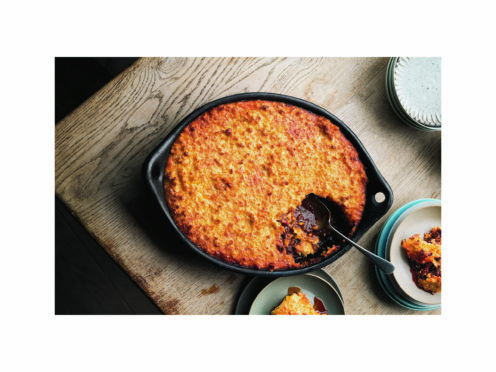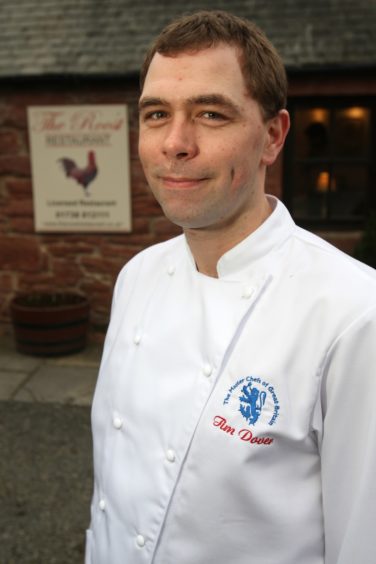This Easter is undoubtedly going to be a different one for everyone, says Tim Dover, chef patron of The Roost restaurant in Bridge of Earn.
Although a religious festival, it signifies a time when families come together and enjoy the spring weather, spending time outside rolling and hunting for eggs, cooking for the family and looking forward to the rest of the year together.
While it is sad that many of can’t celebrate together this year, we are an adaptable nation and I am sure we can bring some Easter happiness into our homes no matter what.
For our main course on Easter Day I’m going to be making slowcooked chicken with a crisp corn crust by Yotam Ottolenghi and plan to have the children help me make it.
To serve six, you’ll need: 3 tbsp olive oil
3 red onions, thinly sliced; 2 garlic cloves, crushed; 3tbsp rose harissa paste; 2 tsp sweet smoked paprika; 850g chicken thighs, skinless and boneless (about 9–10 thighs); 200ml passata; 5 large tomatoes quartered; 200g jarred roasted red peppers, drained and cut into 2cm thick rounds; 15g dark chocolate 70% cocoa solids; 20g coriander, roughly chopped; salt and black pepper.
For the sweetcorn batter you need:70g unsalted butter, melted; 500g corn kernels, fresh or frozen and defrosted (shaved corn kernels from 4 large corn cobs, if starting from fresh); 3 tbsp whole milk; 3 eggs, yolks and whites separated.
Heat the oil in a large sauté pan, for which you have a lid, on a medium high heat. Add the onions and fry for 8–9 minutes, stirring a few times, until caramelised and soft. Reduce the heat to medium and add the garlic, harissa, paprika, chicken, 1 teaspoon of salt and a good grind of black pepper. Cook for 5 minutes, stirring frequently, then add the passata and tomatoes. Pour over 350ml of water, bring to the boil, then simmer on a medium heat, covered, for 30 minutes, stirring every once in a while.
Add the peppers and chocolate and continue to simmer for another 35–40 minutes, with the pan now uncovered, stirring frequently, until the sauce is getting thick and the chicken is falling apart. Remove from the heat and stir in the coriander. If you are serving the chicken as it is (as a stew without the batter), it’s ready to serve (or freeze, once it’s come to room temperature)
At this stage, if you are making the corn topping, spoon the chicken into a ceramic baking dish – one with high sides that measures about 20 x 30cm – and set aside.
Preheat the oven to 180C fan.
For the sweetcorn batter: Pour the butter into a blender with the corn, milk, egg yolks and ¾ teaspoon salt. Blitz for a few seconds, to form a rough paste, then spoon into a large bowl. Place the egg whites in a separate clean bowl and whisk to form firm peaks. Fold these gently into the runny corn mixture until just combined, then pour the mix evenly over the chicken.
Bake for 35 minutes, until the top is golden-brown: keep an eye on it after 25 minutes to make sure the top is not taking on too much colour: you might need to cover it with tin foil for the final 10 minutes. Remove from the oven and set aside for 10 minutes before serving.
Yotam says: “This is a wonderful meal on an autumn day, served with a crisp green salad. The slow-cooked chicken is packed full of flavour and the crust – gluten-free, rich and corny – makes for a welcome (and lighter) change to a heavier mash.
“You can make the chicken well in advance if you want to get ahead: it keeps in the fridge for up to 3 days or can be frozen for one month.
“You want it to go into the oven defrosted, though, so it will need thawing out of the freezer. The batter needs to be made fresh and spooned on top of the chicken just before the dish gets baked, but it then can just go back in the oven.
“It can also be baked a few hours in advance – just warm through for 10 minutes, covered in foil, before serving. I love the combination of the chicken and the corn, but the chicken also works well as it is, served on top of rice, in a wrap or with a buttery jacket potato.”
Extracted from Ottolenghi Simple by Yotam Ottolenghi (Ebury Press, £25) Photography by Jonathan Lovekin.

